CONTENTS

The Best Flowers to Plant in Spring for a Colorful Garden
Spring is a time of renewal and vibrant beauty, where nature awakens from its winter slumber in a burst of colors. If you’re an avid gardener or simply someone who appreciates the beauty of blooming flowers, then you know that spring is the perfect season to bring your garden to life!
Ahead, we will explore the best flowers to plant in spring, ensuring that your garden becomes a kaleidoscope of hues that will leave you and your visitors in awe. Let’s dive in and discover the floral wonders that await!
These Spring Flowers Will Get You Excited for the Season
From elegant pansies to cheerful sunflowers, get ready to embrace the magic of spring as we unveil the top flowers that will transform your outdoor space into a breathtaking oasis of color. Read on!
Pussy Willow
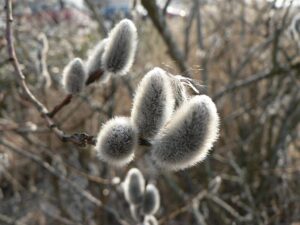
Pussy willow, or Salix, are known for their fuzzy catkins, which are the male flowers of the plant. The catkins are usually grey or silver and have a soft, velvety texture, resembling a cat’s fur, hence the name.
To grow Pussy Willow flowers, it’s important to choose a suitable location in your garden. They prefer temperate climates with cold winters. Also, they thrive in full sun to part shade and can tolerate wet soil conditions, making them an excellent choice for rain gardens or areas with extra moisture.
Keep in mind that they are dioecious, meaning there are both male and female plants. Only the male plants produce the fuzzy catkins characteristic of pussy willows. So, if you want to enjoy charming flowers, select a male plant for your garden.
To moisten the soil, they require regular watering, especially during dry spells. It is best to prune them in late winter or early spring to keep a neat appearance before new growth appears.
Phlox
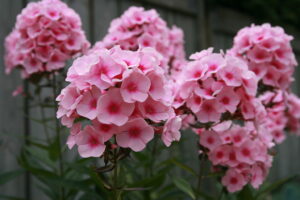
Phlox is a beautiful flowering plant known for its vibrant colors and fragrant blooms, making it a popular choice among garden enthusiasts.
You can plant them in either spring or fall, but if you want to enjoy their blooms during the springtime, it is best to plant them in early spring after the danger of frost has passed.
Several varieties of phlox are available, including Creeping Phlox (Phlox subulata) and Garden Phlox (Phlox paniculata).
To plant this flower, ensure that the planting location receives at least 6 hours of direct sunlight per day for optimal growth as it thrives in full sun to partial shade.
In addition, it prefers well-drained soil that is rich in organic matter. Consider amending your soil with compost or organic matter to improve drainage if it is heavy clay or poorly drained.
Keep the soil evenly moist but not soggy. The best time to water the plants deeply is whenever the top inch of the soil feels dry. You can also mulch around the plants to help them retain moisture and suppress weed growth.
We recommend pruning phlox plants in early spring before new growth appears. Trim back any dead or damaged stems and thin out crowded areas to improve air circulation.
This flower pairs well with other summer-blooming perennials such as lilies, bee balm, rudbeckia, Shasta daisies, yarrow, and clematis.
Pansy
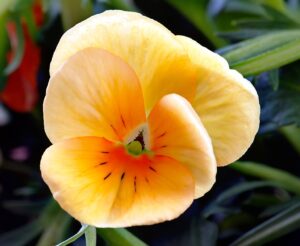
Pansies are vibrant and cheerful flowers known for their characteristic “upturned faces” and heart-shaped petals that come in various bold and bright colors.
One of the great things about this spring flower is that it thrives in cool weather. They are popular choices for spring and fall planting. Also, they are fast-growing and vigorous, making them perfect for early and late-season gardening.
When it comes to sunlight, pansies prefer about six hours of sun daily. However, in warmer regions, protecting them from full sun during the hottest part of the day is best. Too much heat can slow down flower formation.
It’s also worth noting that there are trailing varieties of pansies, such as Cool Wave, which need a minimum of six hours of full sun to flower their best.
In terms of their lifespan, pansies are typically treated as annuals or short-lived perennials. In cooler regions with moderate winters, they may return for a second season of bloom. However, in warmer areas, these delicate flowers may not survive the summer heat and are often grown annually.
This flower is also an excellent choice for pressing! Read here if you’re interested in learning how to press flowers.
Lenten Rose
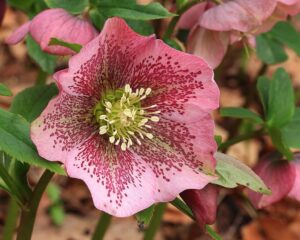
The lenten rose, also known as Helleborus ×hybridus, is a beautiful flowering perennial plant that can be planted in spring. It is often called the “lenten rose” because it blooms from February to April, which coincides with the season of Lent.
They have tough evergreen foliage and produce long-lasting flowers ranging from white and pink to purple and deep burgundy.
When planting lenten roses, choosing a location with partial to full sun and well-drained, fertile soil is best.
In the Midwest, they can tolerate more sun, but in southern regions, they may benefit from some shade. They are relatively drought-tolerant once established but prefer consistent moisture.
These lovely flowers can be enjoyed both in the garden and as cut flowers. When cutting lenten rose flowers, wait until the stamens fall off before cutting the stem to ensure longer vase life—their blossoms can last up to two weeks or even longer in a bouquet!
Flowering Quince
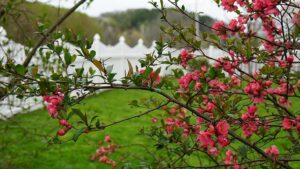
Scientifically known as Chaenomeles speciosa, flowering quince is a deciduous shrub that produces beautiful pink and white blooms that last for several weeks. The flower is medium-sized and scarlet-red, making it highly attractive.
The best time to plant flowering quince is during the winter months when the plant is dormant. Early spring planting is optimal to ensure a healthy establishment.
It thrives in full sun exposure. Although it can tolerate partial sun, providing it with maximum sunlight will enhance the flower display.
To plant this flower, prepare a planting site that is well-drained and enriched with organic matter. You can work well-rotted compost or manure into the soil to improve its fertility.
Remember to water deeply and regularly, especially during the first growing season, so that the roots will be easier to establish. However, be mindful not to overwater, as flowering quince prefers moderately moist soil.
After the flowers fade, you can feed the plant with a slow-release fertilizer once a year. This will provide the necessary nutrients for healthy growth and abundant spring blooms.
This flower blooms on old wood, so it’s important to prune it just after the flowers have finished blooming. This will promote better flower production for the following year.
Marigolds
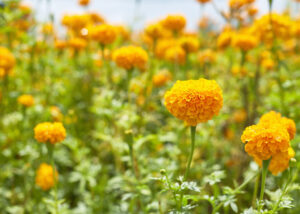
Marigolds have daisy- or carnation-like flowerheads in various bright colors like orange, yellow, and red. They add a lively touch to any garden and attract pollinators like bees and butterflies.
You should plant them in the spring after the last frost has passed. They are warm-season annuals, meaning they thrive in sunny and warm conditions.
On top of that, marigolds love sunlight. Thus, you should plant a sunny spot in your garden, as they need at least 6 hours of direct sunlight every day to grow and bloom beautifully.
Before planting, prepare the soil by adding organic matter like compost or aged manure to improve its fertility and drainage. They also require regular watering, especially during dry periods. However, be careful not to overwater them, as they can be susceptible to root rot. Water at the base of the plants, avoiding wetting the foliage.
In addition, marigolds are known for their natural pest-repelling properties. The strong scent of marigold flowers helps deter insects like mosquitoes, aphids, and nematodes. Thus, planting marigolds alongside vegetables can help protect them from pests.
Sunflowers
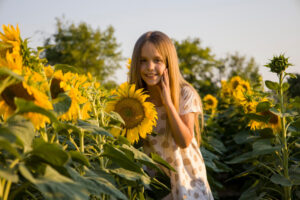
Sunflowers are known for their large, bright yellow blooms and can add a cheerful touch to any outdoor space. On top of that, they attract pollinators like bees and butterflies, which can help improve the pollination of other plants in your garden. They can also act as a natural windbreak and shade other plants.
These flowers should be planted after spring frost has ended when the temperature of the soil is at least 15°C or 60°F. Moreover, they thrive in full sun, so choose a sunny spot in your garden where these flowers can get at least 6 hours of direct sunlight daily.
Before planting, loosen the soil and amend it with well-rotted manure or compost to improve fertility, as they prefer well-drained soil rich in organic matter. Don’t forget to water them deeply but infrequently to encourage deep root growth.
For the planting method, these flowers can be directly sown into the ground. Plant the seeds about 1 inch deep before spacing them 6 inches apart. You can sow multiple seeds in each spot and thin them out later, keeping the strongest seedlings.
Some sunflower varieties can grow quite tall and may require support. Consider staking or providing a trellis to prevent them from bending or toppling over in strong winds.
Frequently Asked Questions
Can I plant flowers in April?
Yes, you can plant flowers in April! Choose flowers suitable for your region, prepare the soil, pick a sunny spot, follow planting guidelines, water them well, and consider using mulch.
Is March too early for flowers?
Due to potential frost, March can be too early for flowers in some regions. Check your local last frost date and opt for cold-resistant flowers if planting in March.
What months are best to plant flowers?
Best months for planting flowers: Spring (March to May) and Fall (September to October). However, you must consider the local climate and frost dates.
Conclusion
In conclusion, spring is the perfect time to transform your garden into vibrant, colorful blooms. By choosing the best flowers to plant in spring, you can create a stunning display that will mesmerize everyone who sets foot in your garden.
But it’s not just about the aesthetics. Planting flowers in spring also benefits the environment. They attract pollinators like bees and butterflies, aiding in the pollination process and helping to maintain biodiversity. Plus, they can improve air quality and create a soothing atmosphere that promotes relaxation and well-being.
When selecting the best flowers for your garden, consider factors such as sunlight requirements, soil conditions, and maintenance needs. It’s important to choose flowers that are well-suited to your specific climate and growing conditions to ensure their success.
So, don’t miss the opportunity to fill your garden with the best flowering plants of spring. Create a colorful and inviting space that will bring joy and beauty to your house garden. Happy gardening!

